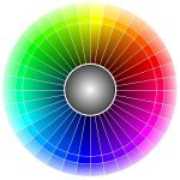Color Fundamentals

Color Properties
- Hue - the color name
- Value - the darkness of lightness of the color. Yellow is the lightest in value; violet is the darkest.
- Intensity - the saturation of color, purity, chroma, brightness/dullness
Hue
Basic, Primary Colors
Red, Yellow, Blue
Secondary Colors (obtained by mixing two primary colors)
Orange, Green, Violet
Intermediate Colors (obtained by mixing a primary with a secondary color)
Red-orange, Yellow-orange, Yellow-green, Blue-green, Blue-violet, Red-violet
Harmony/Contrast
Color Relationships
- Monochromatic - Tones of one color plus white (tints) or black (shades). Color harmony
- Analogous - colors that related by one primary, these colors are next to each other on the color wheel like green, blue-green, blue, blue-violet, and violet. Color harmony
- Complementary - colors across from each other on the color wheel like orange and blue, yellow and violet, and red and green. Color contrast
- Warm and cool - Warm colors have red and yellow in them (reds, yellows, oranges). Cool colors have blue in them (blues, greens). Color contrast
The Psychological Effects of Color
Color affects us on many levels: physical, emotional, and cultural.
Color can make us feel energized or tired, happy or depressed. Red can increase your pulse and blood pressure. Blue can calm and soothe. Everywhere we look, color has historical, traditional, superstitous, or spiritual connotations.
Recommended External Links
COLOR VISION
"Vision and color are at the heart of painting. Here is the most comprehensive discussion for artists of color perception, color psychology, "color theory" and color mixing available online, and one of the most comprehensive available anywhere in any format." Bruce MacEvoy
THE COLOR WHEEL AND COLOR COMPLEMENTS
Ralph Larmann, Art Studio Chalkboard
|
